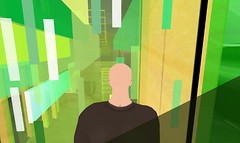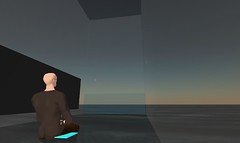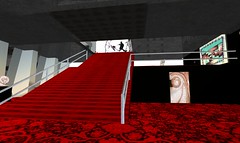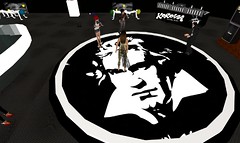Gathering Refuge



In addition to the Royal Institute of Technology Stockholm's
LOL Architects utilizing
Second Life as a tool for architectural education (previously mentioned
here and
here), this
post at
Sharon B's Mindtracks reports at least one more university utilizing the metaverse to teach design and problem-solving skills, namely the School of Architecture and Design at Australia's RMIT University.
Very much like LOL's sim, RMIT Island (
view on map |
direct teleport |
website) is an explosion of ideas that attempts to push the boundaries of architectural possibility, arguably blurring the lines between space, sculpture, graphics, and information in a manner not for the timid and seldom achieved in corporate builds.
While both islands present amazing works ranging from the slightly polemic to the downright esoteric, if the two were to be compared it would seem that the LOL students have had more freedom to define their own project parameters, with the RMIT projects appearing more focused by virtue of a relatively explicit design brief. For example here is the programme for the first of two assignments (the other being a space of gathering) completed over the course of the studio:
Project 1: Lost - A Space of Refuge
Design a space of refuge that is inhabitable by two to three people and examines the architectural relationship between interior, exterior and landscape. Inform this design by reading Borges’ short story on the relationship between the map and its territory, and develop a spatial and cultural understanding of refuge through architectural design.
As a result most of the RMIT projects felt to some degree like buildings as opposed to installations, yet it also seemed like the RMIT students were designing objects to be explored through camming rather than avatar movement. While one is compelled to dispense a healthy amount of leeway given the experimental nature of these works, many were frustrating to navigate and others entirely uninhabitable. In such cases personal impressions quickly degrade from breathless to just huffy.
Among the notable exceptions is Dinah Cortes's take on the Refuge project. In case you were wondering, it's the green thing pictured above. Quoting from the notecard dispensed at the entry:
The sequence of different spaces, lead the visitor to walk through a gradual initiation of darkness, light colours and sounds in being more aware of one’s true nature and relationship to the rest of the existence. Reaching a stage of isolation and contemplation, the viewer can experience a kind of meditative reverence, bringing out the vibrant spirit of nature.
Perhaps excluding the grandiose part about having me relate to the rest of existence, this eye-catching build does what it says. Simple, elegant, expressive, and even a little profound. I'd give it seven thumbs up.
Or maybe just an A.
Korova Milk Bar



Speaking strictly from personal observation, the residents of
Second Life have spent considerable energy creating spaces inspired by literary reference. Some are based on specific authors and works such as John Norman's
Chronicles of Gor, others are simply evocative nods to science fiction and fantasy novels that lack obvious attribution.
Star Wars fandom notwithstanding, there seem to be far fewer spaces drawing their inspiration from traditional cinema (an admittedly clumsy qualifier used to differentiate it from the rise of spaces serving machinima, whether they take the form of backlot sets or personalized screening rooms).
While first envisioned in the words of Anthony Burgess,
A Clockwork Orange is better known from the film that made him infamous, and the Korova Milk Bar in the sim of Geoje (
view on map |
direct teleport |
website) is not the first build in SL to hatch as the spawn of impresario Stanley Kubrick. In the archives of
New World Notes Hamlet Au
reported on Korov-oid tribute spaces dating as far back as 2005. Nor can the genius of the man be contained in-world, as one is reminded every time the grid
goes down - heck, I've even used that flick as a reference in one of my earliest
posts on this site, not to mention a subsequent
review of a prefab known as 'Slightly Droog.'
That hasn't deterred Italian SL residents Mavi Beck and Franci Kubrick from being the latest to settle into the meme and make it their own in a way that (intentionally or not) belies the detached coolness and soulless hedonism depicted in the movie. A shared sense of cinematic immersion seems to instead evoke a kind of kinship with one's fellow avatars that cuts through the usual personal barriers of bling and bootylicious-ness.
Franci and Mavi have out of necessity elaborated upon the stark and partial glimpses of the bar as presented in the film. The walls feature the same scrawled menu of drug-laced dairy products seeping from brightly lit porcelain nudes (although they didn't serve drencrom, which is what I was drinking). Filling in the gaps however are a number of more whimsical elements, like a giant spinning turntable dance floor emblazoned with the giant spinning head of Ludwig Van. The bar itself is accessed by ascending a staircase from an art gallery on the ground floor. While the artworks currently on display are themselves compelling and the framegrab tableau of ultra-violence one encounters at the top of the stairs quite powerful, the entreatment to "Be a Smart Droog - Rent a Shop in Korova Milk Land" takes the whole thing down a peg.
So while these additional elements are executed to varying degrees of conceptual consistency, it could be argued that the flaws of this build are in fact what yield its charms. If one accepts the notion that presence in a literary world is all about disappearing, perhaps presence in a cinematic world is all about being seen. This iteration of the Korova Milk Bar has a definite lived-in feel, infused with the personality of its builders.
All of which leaves your humble narrator unable to look away, and hungry for ticks of toast.






